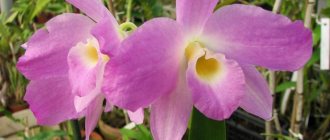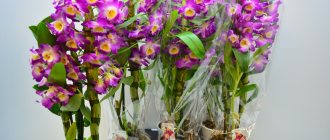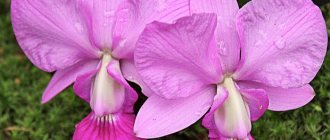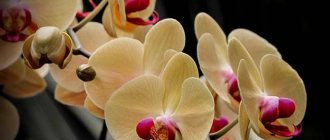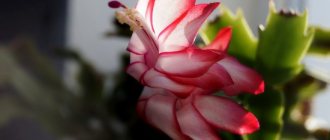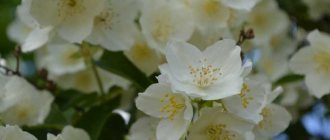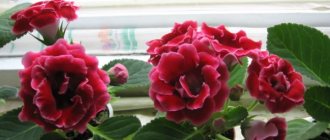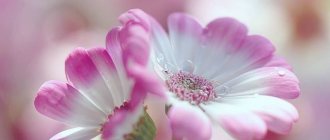Description
Dendrobium is one of the most numerous genera in the Orchid family.
It unites over 1000 species of plants of amazing beauty. These epiphytic flowers have much more differences than similarities. Often, even experienced flower growers and botanists find it difficult to determine the species. The height of the plant varies from millimeters to several meters. Some have thick cylindrical stems, others have spindle-shaped stems, others have reed-like stems, and others are actually swollen pseudobulbs. There are evergreen and deciduous Dendrobiums.
Flowers differ in shape and size, not to mention color. In nature, there are not only blue and black Dendrobiums, but the rest of the palette is presented in full. Despite such diversity, it is flowers that perform the function of unification. All species have a common feature - lateral sepals fused at the base.
Dendrobiums are characterized by long-lasting flowering at home. Some of them also have pleasant aromas. Plants confidently lead the popularity ranking of indoor flowers. Caring for them is not easy. However, it requires, first of all, not so much skill as accuracy and attention. Compliance with the requirements allows not only experienced, but also novice flower growers to achieve impressive success.
Dendrobium orchid - diseases and pests
Like any other house flower, the Dendrobium orchid is susceptible to diseases and attacks from pests - mites, aphids, mealyworms, etc. Let's look at the most common problems:
♦ Often, after purchasing a Dendrobium orchid, you can observe wrinkling of the stems; this problem can be eliminated by proper care of the plant. It is necessary to adjust the light in the room, temperature, and also monitor the water regime and fertilizing;
♦ Why do the leaves of the Dendrobium orchid turn yellow? It is worth revising the lighting intensity or moving the plant to a darker place. In addition, a lack of microelements can cause yellowing of leaf blades;
♦ If the Dendrobium orchid does not bloom, too bright lighting or premature exit from the dormant phase is to blame;
♦ When the pseudobulb turns brown, this indicates the beginning of decay. You can try to cure the plant with Alirin-B, a drug that suppresses the development of fungus. As a last resort, the pseudobulb must be removed;
♦ When pests appear, the flower is treated with special chemical solutions (insecticides and fungicides) and the humidity in the room is increased. A signal about the appearance of harmful insects can be dark spots on the leaves, their yellowing, or the falling of unopened buds. If the infection is detected in the initial stages, it is necessary to treat the foliage and trunk with a soap solution; in case of more serious lesions, spraying with insecticides cannot be avoided, so the drug Molniya prevents the proliferation of spider mites, Fufanol exhibits enteric contact and partly fumigation effects against sucking insects, Bi58 New - systemic a drug that gets rid of ticks, Aktara is an insecticide with enteric contact action.
♦ The appearance of fungal diseases on an orchid indicates a violation of the plant’s watering regime; the situation can be corrected by replanting. All rotten roots should be cut off, dried and treated with charcoal. Afterwards, you can transplant the plant into new soil. After this procedure, watering can be done after 10 days.
With proper care, the Dendrobium orchid may well become a house plant and delight its owners for many years. Take care of your flower and enjoy a beautiful work of wild nature at home.
Growing
Dendrobium does not need spacious containers. It is quite comfortable in a small plastic or clay pot with a good drainage layer, a hanging basket or on a block.
Transplantation is usually carried out every 3–4 years. Overgrown roots indicate the need for the procedure. It is best to move the plant to a larger pot in the spring, being careful not to cover the buds located at the base of the shoots.
Several methods can be used to propagate the plant. First, carefully cut the bush so that each individual rhizome has at least 3 pseudobulbs. This method can be used once every 4 years.
Secondly, wait for 2.5 cm roots to appear on the side shoots. Separate the shoots with a knife and plant them in a special substrate. The flower will require “greenhouse conditions” for six months. You can create a mini-greenhouse at home from a plastic bag (if the plant is small, then just place it in a bag of a suitable size).
And finally, Dendrobium is a representative of Orchids, capable of propagation by cuttings. To do this, the stem is cut into pieces with 2 internodes on each. They are planted in sphagnum for 3–4 months for rooting and leaf formation. Then they are planted in separate pots.
Dendrobium Jenkins
Dendrobium is named after Captain Jenkins, who first discovered this plant in the Indian state of Assam.
Growth:
This plant is widespread in India and Southeast Asia. Its range extends east from northwestern India, including Sikkim, Bhutan, Assam, Myanmar, northern Thailand, Laos and Yunnan province in southwestern China. This Dendrobium usually grows on thick branches of deciduous trees. The altitude of this orchid's habitat ranges from 500 m above sea level in northeast India to 2000 m in more southern regions.
Climate in natural habitats:
- Fixed temperature range from –1°C to +37°C.
- Humidity is almost 85% in summer, and drops to 70–80% in autumn and winter.
- Precipitation ranges from 5–8 mm. in December and January up to 818 mm. in July.
- Average temperatures (day/night) in summer are +29°C/+22°C, and in winter +20–22°C/+7–9°C.
Description of the plant:
Plant size and type:
Sympodial epiphyte 6–10 cm high.
Pseudobulbs:
Pseudobulbs are 3–5 cm long, ovoid, flattened, covered with grooves, growing in close groups.
Leaves:
Each growth produces one oval, thick and shiny leaf 3–5 cm long, which remains on the plant for several years.
Peduncle:
A short pendulous peduncle grows from the base of a leafy pseudobulb. The flowers rise slightly above the leaves.
Flowers:
Each peduncle bears one or two golden flowers. The flowers are quite large compared to the size of the entire plant, their diameter is 3 cm. Dendrobium Jenkins flowers last up to three weeks. The petals are much wider than the sepals. The large heart-shaped lip is covered with villi. The flowers of Dendrobium Jenkins are very similar to those of Dendrobium Lindley, but the latter has a multi-flowered inflorescence and the lip is not covered with down.
Flowering period: from December to July, peak flowering occurs in spring.
Agricultural technology:
Temperature:
In summer, the average daytime temperature is +29°C, the average night temperature is +22°C, which gives a daily temperature difference of 7°C. These are the temperature conditions in the warmest areas where this orchid lives. At higher altitudes, temperatures can be 3–6°C lower.
Lighting:
25000–35000 lux. In nature, plants receive the least sun in the summer, since the sky at this time is covered with a thick layer of clouds.
Watering:
Precipitation is very heavy during the five summer months and very light during the five winter months, with short transition periods in autumn and spring. In cultivation, the plant's substrate should be evenly moist from spring to early autumn, and when new growth reaches maturity in late autumn, watering should be gradually reduced.
Fertilizer:
It is recommended to feed 1/4 to 1/2 dose of orchid fertilizer weekly. From spring to mid-summer, you need to give a fertilizer with a high nitrogen content, and then until the end of autumn, a fertilizer with a high phosphorus content. In summer, the plant should grow quickly so that the next season will bloom more abundantly.
Substrate:
This Dendrobium will grow best on a block of wood, cork or tree fern if the plant is kept in high humidity and watered at least once a day in the summer. When growing in pots, use any loose and quickly drying substrate. It is best to replant in early spring, when new roots begin to grow.
Air humidity:
Nearly 85% drops to 70–80% in the summer, fall, and early winter, before dropping to 55–60% in late winter and early spring.
Rest period:
In winter, the average daytime temperature is +20–22°C, the average night temperature is +7–9°C, as a result of which the daily temperature difference increases to 13°C. In nature, precipitation is insignificant in winter, but plants receive additional moisture in the form of abundant dew that often forms. However, for about a month in late winter or early spring, the air humidity is so low that dew does not form. In winter, the substrate of the growing plant should dry out between waterings, but it should not be allowed to remain completely dry for too long. To avoid excessive drying out, the plant must be sprayed from time to time. This should be done in the morning, best in warm sunny weather. Feeding is stopped until spring, when abundant watering resumes. Cold dry dormant period with simultaneous increase in light
Note: Many gardeners find Dendrobium Jenkins difficult to care for, so special attention should be paid to the conditions of this plant during the dormant period.
Editorial team LePlants.ru
First steps after purchase
The purchase of Dendrobium should be preceded by a thorough inspection of the leaves. Specks, stripes, thickenings are evidence of the presence of pests. The plant should be transported to a new place of residence in secure packaging. Even short-term hypothermia is fraught with the dropping of flowers and buds. Transplantation into “fresh” soil and amputation of dried roots must be carried out immediately. At least 3-4 days should pass before the first watering. Since the symptoms of fungal and viral infections are hidden at first, the flower requires a 2-week quarantine to avoid mass infection. The plant does not have to be placed on the windowsill immediately. During the adaptation period, Dendrobium can be placed a meter from the window.
Methods for propagating dendrobium at home
Dividing the bush.
This method of propagation is applicable to mature, well-grown plants. The division is carried out during transplantation, while the roots of the dendrobium are completely freed from the substrate and carefully untangled, heavily tangled areas are cut with a knife, and the cut areas are treated with crushed charcoal or activated carbon.
When dividing, it should be taken into account that each division must have at least 2-3 mature bulbs and the same number of mature young shoots. Each young specimen is planted in its own container and immediately placed in its usual place for growth. Such young dendrobiums begin to grow quite quickly.
Cuttings.
The pseudobulb is cut from the mother plant and cut into cuttings at least 7 cm long. Each cut is sprinkled with activated charcoal or charcoal. There are 2 ways to root cuttings, but the essence and result do not change much, you can choose the appropriate one:
- Way. The cuttings are placed in a bag with damp sphagnum moss and tied tightly. The package itself is placed in a warm (23-26 °C) well-lit place;
- Way. The cuttings are placed in a shallow container filled with damp sphagnum moss, then covered with a transparent bag. Place the container in a warm (23-26 °C) well-lit place.
Every day, the greenhouses are ventilated and, if necessary, the sphagnum moss is additionally moistened with a spray bottle. On average, rooting takes 2 weeks or more. Plants are planted when the roots reach at least 2-3 cm in length. Dendrobiums grown in this way will bloom no earlier than in 2-3 years.
Secrets of success
Dendrobium is photophilous. Some species can tolerate direct sunlight without harm to their health. However, most representatives of the genus prefer to grow in light shade.
The temperature regime of an Orchid depends on its belonging to a particular species. Plants that love cool weather do well in the warm season at temperatures up to 18°C during the day and 15°C at night. Daytime winter temperature should not exceed +12°C, nighttime - 8°C. For heat-loving species, optimal summer temperatures are + 25°C during the day, + 20°C at night. In the winter months - 20 and 18°C, respectively. All members of the genus, without exception, benefit from regular ventilation.
Dendrobiums require high air humidity. It is recommended to place pots in pallets. It is also permissible to finely spray the air near the plant, but so that not a single drop falls on either the leaves or flowers.
Abundant watering during active growth (warm shower or immersing the pot in water) upon the onset of the dormant period is reduced to rare water procedures as the earthen clod dries completely. It is recommended to use soft, settled water at room temperature.
Feeding with special fertilizers is carried out only during the growing season and completely stops at the end of flowering.
Dendrobium flowering, how to stimulate flowering
This orchid blooms for 2 to 3 months.
In order to make dendrobium bloom, the main rule must be followed - it is to observe the difference in day and night temperatures, which should be no more than 5 °C. In summer this is not a difficult condition; in winter, when heating devices are operating, you need to be cunning and take the pot with the plant into the coolest room.
To stimulate flowering, some gardeners resort to various tricks, for example, there is a scheme:
- Do not water the orchid until a new 40 mm growth appears and grows its roots. After which watering is resumed;
- When the growth becomes equal to the old bulbs, gradually reduce watering until it stops completely, simultaneously lowering the temperature to 12 °C;
- Watering is resumed as soon as the buds begin to bloom. Otherwise you can end up with a lot of children.
Dendrobium amabile. ©snotch
